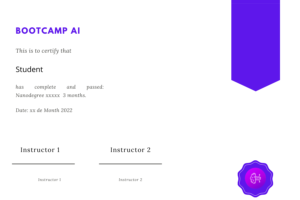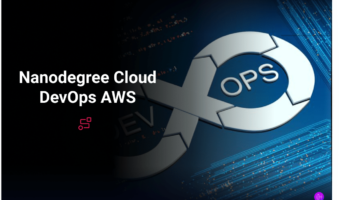Welcome to Bootcamp AI
02. Project Reviews
Access the Career Portal
How Do I Find Time for My Nanodegree?
Introduction
What you are going to build
Prerequisites
Sign in to AWS and monitor costs
What is needed
Cloud Computing
The cloud has become a key enabler for innovation with beneficial features like high availability, unlimited
capacity, and on-demand scalability and elasticity. Learn the fundamentals of cloud computing while being
introduced to compute power, security, storage, networking, messaging, and management services in the cloud.
While learning the fundamentals, you will explore tools and services offered by Amazon Web Services (AWS)
through interactive hands-on exercises. By the end of the course, you will have deployed your first website to AWS,
and you will be prepared to continue your learning journey in the Cloud Developer Nanodegree program
What is Cloud Computing?1:16Preview
Test
Types of Cloud Computing1:16Preview
Test
Cloud Computing Deployment Model1:12Preview
Test
Test
Test
Test
Shared Responsibility Model1:16Preview
Test
Lab: Setup free-tier account
Foundational & Compute Service
Why do we need servers in the cloud?1:12Preview
Elastic Cloud Compute (EC2)00:00:00Preview
Demo – Elastic Cloud Compute (EC2)00:00:00Preview
Test
EC2 – Connect to Linux InstancePreview
Elastic Block Store (EBS)00:00:50Preview
Test
Demo – Elastic Block Store (EBS)1:41Preview
EC2 – EBS Dashboard
Why do we need security in the cloud for our servers?0:39Preview
Virtual Private Cloud (VPC)1:09Preview
Test
Lab – Launch an EC2 instancePreview
Why do we need compute power in the cloud?00:00:00Preview
Test
Lambda – Create a Function00:00:00Preview
Lab – Create and execute a Lambda00:00:00Preview
Test
Lab – Deploy App to Beanstalk
Storage & Content Delivery
Why do we need storage in the cloud?00:00:00
Test
S3 – Create a Bucket
S3 & Glacier00:00:00
Test
Demo – S3 & Glacier00:00:00
DynamoDB00:00:00
Test
DynamoDB – Create a table00:00:00
Lab: DynamoDB
Relational Database Service (RDS)1:46
Test
Demo – Relational Database Service (RDS)2:29
RedShift1:26
Test
Lab – RDS
Why do we need content delivery in the cloud?00:00:00
Cloud Front00:00:00
Test
Demo – Cloud Front00:1:41
Lab – S3 & Cloud Front
Lesson Recap00:00:00
Security
Why do we need security for applications?1:07
AWS Shield00:00:00
Test
AWS Web Application Firewall0:50
Test
Identity & Access Management00:00:00
Test
Demo – Identity and Access Management (IAM)00:00:00
Lab IAM
Lesson Recap00:00:44
Networking & Elasticity
Why do we need networking in the cloud?1:54
Test
Route 5300:00:00
Test
Why do we need elasticity in the cloud?00:00:00
Test
EC2 Auto Scaling00:00:00
Test
EC2 – Create Auto Scaling group
EC2 – Grupo de Auto Scaling
Demo – EC2 Auto Scaling00:00:00
Elastic Load Balancing00:00:00
Test
Demo – Elastic Load Balancing00:00:00
EC2 - Elastic Load Balancing
EC2 – Laboratorio NLB
Lab - EC2 Auto Scaling
Lesson Recap00:00:00
Messaging & Containers
Why do we need messaging in the cloud?00:00:59
Test
Simple Notification Service (SNS)00:00:40
Test
Demo – Simple Notification Service (SNS)00:00:00
Why do we need queuing technology?00:00:52
Test
Simple Queue Service (SQS)00:00:00
Test
Demo – Simple Queue Service00:00:00
SQS – Create a Queue
Lab – SNS
Why do we need containers?00:1:16
Test
Elastic Container Service (ECS)00:00:00
Test
Demo: Elastic Container Service00:00:00
Lesson Recap00:00:00
AWS Management
Why do we need logging and auditing in the cloud?00:00:00
Cloud Trail00:00:00
Test
CloudTrail - Create a Trail
Demo – Cloud Trail00:00:00
Cloud Watch00:1:03
Test
Demo: Cloud Watch00:00:57
Lab: Cloud Watch
What is Infrastructure as Code and why do we need it?00:00:57
Cloud Formation00:00:00
Test
Demo – Cloud Formation00:00:00
Lab: Cloud Formation
AWS Command Line Interface (CLI)00:00:00
Demo – AWS Command Line Interface (CLI)00:00:00
Lesson Recap00:00:00
Course Recap00:00:00
Deploy Static Website on AWS
Create S3 Bucke
Upload files to S3 Bucket
Secure Bucket via IAM
Configure S3 Bucket
Configure S3 Bucket 2
Distribute Website via CloudFront
Access Website in Web Browser
Project Description – Deploy Static Website on AWS
Lista de verificación de envío de proyectos
Project Rubric – Deploy Static Website on AWS
Getting Started with CloudFormation
With the advent of cloud computing, along came several tools that enabled us to deploy the underlying
infrastructure components that provide security and services to our servers by writing scripts. In this course,
you’ll learn how to deploy this infrastructure using CloudFormation, AWS’ tool for Infrastructure as Code.
You will use CloudFormation to deploy Infrastructure patterns that are used broadly in the industry and
can be readily used to deploy any cloud application. Like in the real world, you will begin with initial business
requirements that you will turn into Cloud Architecture Diagrams. Then, you will deploy this architecture using
CloudFormation
What is Cloud Computing?1:08
Why you need Cloud DevOps2:39
What are the benefits of Cloud DevOps?1:59
What are the benefits of Cloud DevOps? 21:47
Set up Tools 13:04
Test
Creating Access Key ID5:24
Test
Configuring AWS CLI3:52
Test
Adding Additional Keys1:40
Understanding CloudFormation2:09
Test
Getting Started With CloudFormation Script6:22
Test
Testing CloudFormation7:40
Creating a VPC: Manually vs Automated3:01
Exercise – Create a VPC: Automated7:40
Exercise – EC2 Instance with an Admin Role
Configuring AWS API User6:07
Automating with CloudFormation00:1:21
Test
Verifying in console00:00:00
Test
Conclusion1:02
Infrastructure Diagrams
Lesson Overview
Generalizing to other cloud providers1:28
Setting up Lucidcharts2:29
Test
Exercise: Setting Up Lucid Charts
Diagramming AWS Accounts and Regions2:41
Test
Exercise: Diagramming AWS accounts & regions
Diagramming Availability Zones3:28
Test
Exercise: Diagramming Availability Zones
Virtual Private Cloud5:21
Exercise: Virtual Private Cloud
Public vs Private Subnets2:34
Test
Exercise: Public vs Private Subnets
IGW Internet Gateway3:36
Test
Exercise: IGW Internet Gateway
Network Address Translation1:55
Exercise: NAT’s
Autoscaling groups4:10
Exercise: Autoscaling Groups
Load Balancers 12:47
Load Balancers 21:49
Exercise: Load Balancers2:48
Security Groups1:54
Test
Exercise: Security Groups
Routing Table00:2:05
Routing Table 1
Routing Table 200:1:50
Exercise: Routing Table
S31:50
Test
Exercise: S3
Reviewing Our Diagram1:59
Test
Summary0:46
Networking Infrastructure
Workflow and Helpers4:55
VPC and Internet Gateway 14:55
Demo: creación de subredes, parte 26:54
Demo: creación de subredes, parte 32:40
NAT Gateway And Subnets Part 15:51
NAT Gateway And Subnets Part 25:10
Demo – Create NAT Gateway – Part 32:16
Demo – Create NAT Gateway – Part 42:28
Demo – Verify NAT Gateway in the Web Console 54:06
Routing
Test
Demo – Route Tables Part 15:34
Demo – Associate Route Tables to Subnets Part 22:36
Demo – Verify Route Table Creation in the Web ConsolePart 34:18
Outputs4:39
Outputs ll3:35
Conclusión0:25
Challenge
Servers and Security Groups
Setting Up Our Environment2:55
Understanding Security Groups3:23
Test
Security Groups00:5:21
Creating Autoscaling Group00:00:00
Test
Launch Configuration00:00:00
UserData script
Debugging Launch Configuration00:00:00
Test
Launch Templates
Adding Target Groups and Listeners00:00:00
Updating the Stack with the Load Balancer00:00:00
Debugging Our Security Group00:00:00
Final Review00:00:00
Conclusion00:00:30
Connect to private servers via a Jumpbox
Challenge 3
Prerequisites
Overview
Prerequisites
Overview
Storage and Databases
Intro1:22
Test
RDS Databases (Part One)5:40
RDS Databases (Part Two)6:42
Test
RDS – Create Aurora database
RDS Database (Part Three)00:00:00
Test
RDS Database (Part Four)
S3 (Part One)00:00:00
S3 (Part Two)00:00:00
Test
S3 (Part Three)00:00:00
Test
Key Points00:00:00
Test
Exercise
Conclusion00:00:00
Monitoring & Logging
In this course, you’ll learn the process of taking software from source code to deployment and beyond.
You’ll learn about automated testing, choosing the right deployment strategy for your business needs and
deploying an appropriate CI/CD pipeline. You’ll also learn about monitoring and logging to ensure that your
application is running at peak performance and stays that way.
You’ll also learn to manage and make changes to your servers in an automated way, using Ansible, a leading
Configuration Management tool.
Prerrequisitos1:21
Introduction to Continuous Delivery3:02
Continuous Delivery Is Important2:17
Stakeholders2:45
True North2:45
Principles of Continuous Delivery00:00:00
Course Outline00:00:00
Tools, Environments & Dependencies0:23
Project: Give Your Application Auto-Deploy Superpowers1:19
Good Luck!00:00:00
Continuous Integration and Continuous Deployment—
Introduction to CI/CD1:08
Big Picture2:45
Intuition CI / CD3:02
Fundamentals of CI/CD00:4:10
Benefits of CI/CD4:08
Exercise: Benefits
Solution: Benefits0:58
Best Practices5:14
Continuous Integration and Continuous Deployment Strategies —
Deployment Strategies5:39
Blue Green Deployment2:12
Pipeline Building Blocks00:00:00
Exercise: Pipeline
Solution: Pipeline3:43
CI/CD Tools3:39
Test –
Lesson Conclusion00:00:00
Building a Continuous Integration Pipeline –
Introduction2:17
Big Picture00:00:00
Intuition00:00:00
Creating Pipelines00:00:00
Test –
Anatomy of a config.yml File00:00:00
Creating Jobs00:00:00
Exercise: Creating a Simple Workflow
Solution: Creating a Simple Workflow00:00:00
Environment Variables00:00:00
Environment Variables 2
Exercise: Environment Variables
Solution: Environment Variables00:00:00
Triggering00:00:00
Exercise: Trigger Existing Workflow
Solution: Trigger Existing Workflow00:00:00
Sharing Information00:00:00
3rd Party Secret Keepers
Exercise: Sharing Files
Solution: Sharing Files00:00:00
Reusable Job Code 200:00:00
Exercise: Reusable Job Code
Solution: Reusable Job Code2:14
Job Failures00:00:00
Exercise: Job Failures
Solution: Job Failures00:00:00
Create a CI Pipeline00:00:00
Exercise: Create a CI Pipeline
Solution: Create a CI Pipeline00:00:00
Lesson Conclusion00:00:00
Enabling Continuous Delivery with Deployment Pipelines
Introduccón2:43
Big Picture2:47
Intuition5:42
Configuration Management2:07
Design an Ansible Playbook 13:58
Design an Ansible Playbook 23:22
Exercise: Define Ansible Playbook
Solution: Define Ansible Playbook1:13
Build an Inventory File2:29
Exercise: Inventory File
Solution: Inventory File0:49
Remote Control Using Ansible4:20
Exercise: Remote Control Using Ansible
Solution: Remote Control Using Ansible
Solution: Remote Control Using Ansible5:51
Deployment Jobs0:54
Infrastructure Creation Jobs00:00:00
Exercise: Infrastructure Creation
Solution: Infrastructure Creation00:00:00
Configuration and Deployment Jobs00:00:00
Exercise: Config and Deployment
Solution: Configuration and Deployment0:40
Smoke Testing Jobs00:00:00
Creating a Smoke Test00:00:00
Exercise: Smoke Testing Jobs
Solution: Smoke Testing Jobs00:00:00
Rollback Jobs00:00:00
What Do I Need for This Job?—
Exercise: Rollback
Solution: Rollback
Production Candidate Promotion Jobs–
Exercise: Promote to Production
Solution: Promote to Production–
Lesson Conclusion —
Monitoring Environments
Introduction2:18
Big Picture1:38
Intuition About Monitoring1:53
The Case for Monitoring 13:12
The Case for Monitoring 200:2:53
Monitoring Tools1:28
Monitoring Tools 22:19
Set Up Prometheus 17:59
Set Up Prometheus 21:06
Exercise: Prometheus
Solution: Prometheus0:31
Exporters 10:53
Exporters 22:07
Deploy an Event-Driven Microservice
In this course, you will learn to create and deploy a Kubernetes cluster, configure Kubernetes autoscale, and
load test a Kubernetes application. You’ll learn to operationalize both existing and new microservices, and
apply containers best practices. You’ll learn to deploy Machine Learning microservices that are elastic and
fault tolerant. You’ll learn to pick the appropriate abstraction for microservices: Serverless (AWS Lambda) or
Container Orchestration (Kubernetes).
Functions as a Service (FaaS)3:24
A Model for Serverless2:53
Lesson Outline
Benefits of FaaS1:16
Test
Cloud-Native3:49
Characteristics of Cloud-Native Systems1:51
Test
AWS Account & Resources
Cloud9 Environment–7:14
Lambda Functions00:00:00
Test
Deploying and Testing4:33
Tutorial: Making Change
Event-Handling00:00:00
Events & Response00:00:00
Test
Create a Test
Test
Deploy & Use API Gateway—00:00:00
Local Requests –00:00:00
Creating a Virtual Environment
Test
Exercise: Wikipedia
Exercise Code
Exercise: Wikipedia–00:00:00
Test & Response00:00:00
Lesson Summary00:00:00
Using Docker Format Containers
Docker Containers2:00
Exercise: Setting Up a Local Environment2:49
Test
Makefiles4:17
Test
Makefile Creation Recap
Exercise: Create A Basic Makefile
Install Docker00:00:00
Linting and CircleCI00:00:00
Test
Running Dockerfiles
Setup AWS Docker Project00:00:00
Running Dockerfiles00:00:00
Exercise: Deploying to Amazon ECR00:00:00
Lesson Summary00:1:26
Test
Containerization of an Existing Application
Exercise: Docker Based Apps00:3:20Preview
Test
Install Packages00:00:53
Setup Cloud9–3:37
Copying an Application3:37
Test
App Setup0:44
Test
App Start00:1:10
Test
Exercise: Build and Deploy00:3:20
Test
Exercise: Containerize an App
Summary00:1:14
Container Orchestration with Kubernetes
Test
Overview of Kubernetes00:3:41
Test
Monitoring, Logging and Debugging with Kubernetes1:01
Exercise: Prometheus Monitoring
Exercise: Logging
Exercise: Debugging00:4:53
Autoscaling with CPU or Memory00:00:00
Test
Summary00:00:00
Operationalizing Microservices
Alerts and Incidents Response00:1:03Preview
Test
Disaster Recovery00:3:14
Test
CI/CD Pipeline Integration00:3:02
Test
Exercise: CircleCI
Load Testing00:1:11
Exercise: Locust Load Testing00:5:52
Summary00:00:00
Course Wrap Up00:00:00
Operationalize a Machine Learning Microservice API
Introduction1:17
Project Overview
Project Structure & Files
Create the Project Environment
Detailed Project Tasks
Project Description – Operationalize a Machine Learning Microservice API
Project Submission
Project Rubric – Operationalize a Machine Learning Microservice API
Job
Find your dream job with continuous learning and constant effort
Job Search Mindset1:27
Target Your Application to An Employer3:01
Open Yourself Up to Opportunity00:00:00
Refine Your Entry-Level Resume
Convey Your Skills Concisely1:23
Effective Resume Components00:00:00
Resume Structure00:00:00
Describe Your Work Experiences00:00:00
Resume Reflection00:00:00
Resume Review00:00:00
Craft Your Cover Letter
Get an Interview with a Cover Letter!00:00:00
Purpose of the Cover Letter00:00:00
Cover Letter Components00:00:00
Write the Introduction00:00:00
Write the Body00:00:00
Write the Conclusion00:00:00
Format00:00:00
Optimize Your GitHub Profile
Introduction00:00:00
GitHub profile important items00:00:00
Good GitHub repository00:00:00
Interview Part 100:00:00
Identify fixes for example “bad” profile00:00:00
Identify fixes for example “bad” profile 200:00:00
Quick Fixes #100:00:00
Quick Fixes #200:00:00
Writing READMEs00:00:00
Interview Part 200:00:00
Commit messages best practices
Reflect on your commit messages00:00:00
Participating in open source projects00:00:00
Interview Part 300:00:00
Participating in open source projects 200:00:00
Starring interesting repositories00:00:00
Develop Your Personal Brand
Why Network?2:01
Why Use Elevator Pitches?2:04
Personal Branding
Elevator Pitch1:08
Pitching to a Recruiter0:51
Why Use Elevator Pitches?1:41









